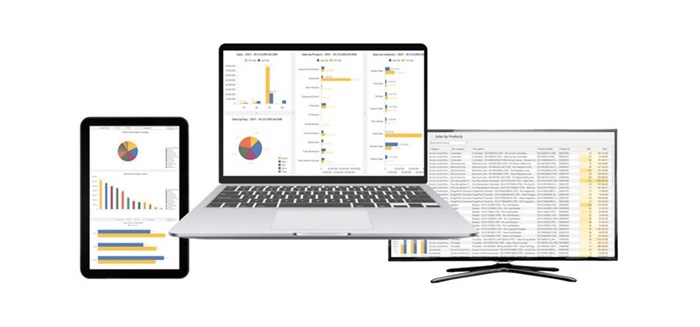Enterprise resource planning (ERP) is pretty astonishing when you think of it. One single system that is the spinal cord of your entire business. It connects everything from front of house sales and CRM, estimates and quotes, to the very engine room of your business – production management, time tracking, supplier and inventory management, and culminates to the all-important finance and reports.
When you want to keep your finger on the pulse, your ERP system is the finger.
So, what about production management? Well, whether your business provides digital services, such as design, architecture, software development, or marketing, or you provide manufacturing services, an essential part of operational success is managing your production.
In all of these cases, production management usually entails a project with a specific list of tasks to be completed, within a certain timeline, and according to an agreed budget. Once you have a few important elements in place, your ERP system can help you do that, and more, better.
How to help your ERP system help you
While ERP is widely adopted around the world (88% to be precise) because it simplifies operations and streamlines efficiencies, it is not the silver bullet that will single-handedly manage your production for you, straight out of the box. However, it will greatly assist you, if you are able to manage a few important details first.
- Break it down. Your project can be broken down into a specific set of tasks. Create an accurate task list with tasks that are detailed enough for the operator to understand. This can be itemised on your ERP and will reflect on your work order.
- Tick tock (and we don’t mean the social media platform). Each of these tasks will take a certain amount of time. Estimate and note the time that each task will require. This will be included in your estimate calculation on your ERP system. If you don’t have this, your ERP cannot estimate accurately.
- Make provision for collaboration. If tasks are customer-facing, or require collaboration (a meeting), make sure tasks include a calendar event and everyone attending is invited. This can be scheduled in your ERP.
- Plan with Actual Intelligence (it still trumps AI). While artificial intelligence and machine learning are great, we still need production management to be managed by you, with care and thought.
- Don’t bottleneck your pipeline. Assign tasks timeously. You will create a culture of burnout if you assign all tasks for that or the next day, all with maximum urgency. This is not profitable or sustainable. At a minimum the next two days to two weeks need to be planned ahead, depending on the nature of your business. Your ERP should allow you to assign tasks to equipment, as well as individuals.
- Don’t starve your pipeline. Don't assign tasks too early - keep your production pipeline loaded with only a small buffer.
- Never compromise on tracking. Enforce detailed progress tracking and timekeeping. Without it, it is like trying to find your way on a map if you don't know your location. Your ERP will help you here.
- Manage your constraints. This is a big one that ensures a culture of continuous improvement. Continue to identify and remove your production constraints. This is known as the Theory of Constraints (TOC). When you highlight and optimise the critical bottleneck within your company, the business can leverage your ERP system to focus on the most impactful areas. Here’s a brief overview of how to do that.
- Identify and optimise: Identify the bottleneck or constraint that limits the system’s output. It could be a machine, a process step, a department, or even market demand. For a printer, it might be a high-demand press; for a software company, perhaps it's the design phase; for a manufacturer, maybe it's a specific assembly line.
- Exploit and subordinate: Once identified, see how you can make the most efficient use of the constraint.
- Elevate and excel: If, after exploiting and subordinating, the constraint still limits performance, the next step is to increase capacity. This might mean buying in new or more equipment, hiring more staff, adding overtime, or finding other ways to enhance the throughput at the constraint.
- Iterate to improve: Repeat, repeat, repeat. Once that constraint is resolved, go back to the first step and identify the next constraint because the bottleneck may have shifted. The process of optimisation is ongoing in your pursuit of continual improvement as you elevate your operation once again.
- Build in a buffer. The final key element that you need in your production management is to include a buffer in front of your constraint, so that upstream delays don't affect your constrained process.

Here’s how ERP is the ideal tool to help you manage production
Great! Once you have all of the above in place, your ERP system can take over and automate processes. Here’s how QuickEasy BOS ERP can help your production management.
- Automatic task creation. Once your tasks are entered into the ERP, you can create a standard library of tasks, and ‘drag and drop’ them as it were into your new project with ease, and tweak as needed.
- No more guesstimating. Now that you have time allocated to each task in your ERP, it is easy to accurately estimate each project’s costs with a few simple clicks, based on whatever your model is, so you don’t lose profit.
- Track time like a professional hunter. Now you can immediately see where you are underquoting or overinvesting. The ERP’s time tracker is what drives accurate estimating going forward.
- Constraint identification. Your ERP can quickly help you see where your bottlenecks are. This allows you to manage your constraints, make informed decisions about equipment, staff, and operations towards your goals of continuous improvement.
- Material Requirements Planning (MRP). If you are in manufacturing or printing, then your ERP has built-in materials management functionality that ensures you have the right material available when production is scheduled to start.
- Dashboards for clarity, calm, and control. Your ERP collates, cleans, and organises your data so that you have instant insights and reporting on a project's progress.
QuickEasy BOS ERP is every production managers partner in success
Technology is always meant to support and enhance what we, as skilled people in the workplace, do on a daily basis. QuickEasy ERP is a people-centric software that automates the mundane, repetitive tasks that typically take so much time out of your day, so that you and your team can get more done, faster. Talk to us about a demo today!



























































